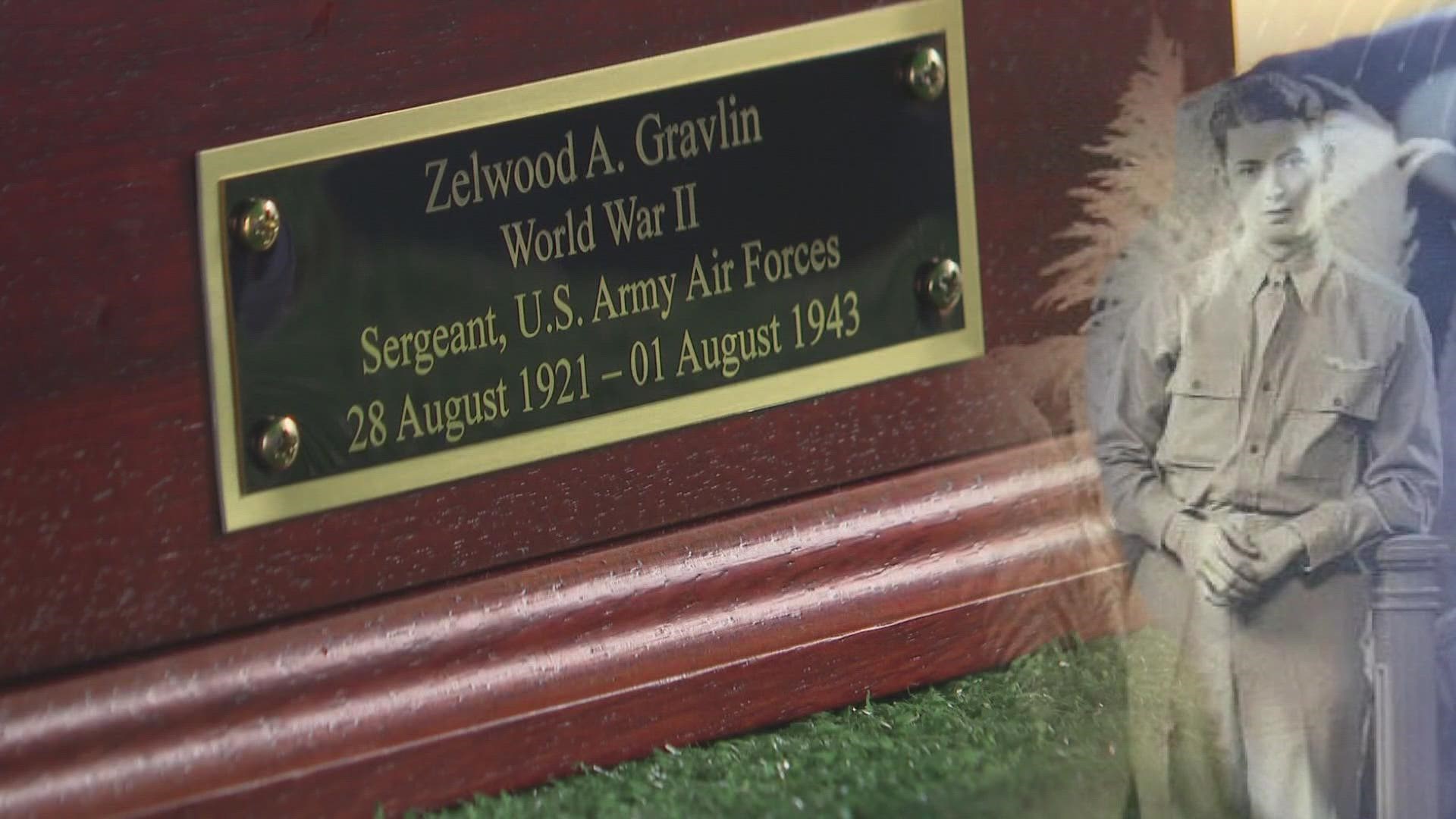PHILLIPS, MAINE, Maine — The old community center was filled with people, and in back were tables filled with food. Soldiers stood outside in the November rain — two others stood inside, folding an American flag, while the crowd of mostly local people watched in silence.
79 years after he died, Sgt. Zelwood Gravlin was welcomed home, with full military honors.
“Its kind of bittersweet,” Susan White, Gravlin's great-niece, said. White led her family’s long effort to identify the soldier’s remains and bring them back to Maine.
Gravlin grew up in Phillips, went to work in Connecticut and then joined the Army as a 20-year-old in World War II. He was assigned as a gunner on board a B-24 Liberator bomber, part of the 343rd Bombardment Squadron.
August 1, 1943, 177 of the bombers flew out of Libya to attack the Ploesti oil refinery in Romania. The oil fields there and the refinery were crucial fuel sources for the Nazi war machine.
It was a low-altitude bombing mission, with the planes flying just a few hundred feet above the ground—making them easy targets for German guns. The refinery was hit and significantly damaged, but at a terrible price for the Americans.
51 of the planes didn’t return from that mission, according to Army records, and at least 225 of the roughly 500 crew members were lost. Sgt. Gravlin was one of them.
For his family, however, Gravlin was considered missing in action. There was nobody to send home because his plane went down in what was then enemy territory.
“My great-grandmother never really believed he was gone," White said.
She said her great-grandmother, who was Gravlin’s mother, wasn’t convinced until a package arrived from the Army.
"They sent his personal belongings to her, and the story goes, there was a letter in there he had written three days before he died and was never sent. And when she got that letter, she never opened it but she knew he was gone."
White said Gravlin’s mother never opened that letter and asked the family to keep it sealed while she was alive, which they did. Not until more than 50 years later did Susan’s uncle finally get to open it.
“He had been searching for years, and he got to open it,” she recalled.
White said the letter itself was not remarkable, mostly Gravlin telling his mother not to send him so much postage for other letters.
Holding the letter for all that time, however, may be an indicator of how the family continued, through four generations, to press the government to keep searching for his remains.
“Before [my Dad] died, he asked me if I would keep it going. That’s been 20 years. And I kept it going,” White said.
In July of this year, the searching stopped. White got a call from the Defense POW/MIA Accounting Agency.
“They said, 'I hope you’re sitting down. We found him.' I thought he was joking. I literally couldn’t sit in my chair. It was surprising.”
After their planes were shot down in the Ploesti raid, Gravlin’s body and others were buried by civilians in a Romanian cemetery, but there were no dog tags or other ID with them. After the war ended, the defense department moved the remains to American cemeteries in Belgium, but still, no one knew who they were.
In Gravlin’s case, that finally changed this summer, when Army investigators were able to match family DNA to his particular remains.
He was MIA no longer.
On Saturday, outside the community center, family friend Tom Saviello lifted a wooden box out of the hearse and presented it to Susan.
“Welcome home, Zelwood,” she said quietly.
“It's been a long time.”
In the memorial service, Saviello spoke of Gravlin leaving the community, never to return, and of the family’s ongoing efforts to identify him.
Maine Adjutant General Douglas Farnham spoke of the many airmen killed in the Ploesti raid.
“Because it reminds us of the ultimate sacrifice those of us who put the uniform on are sometimes asked to make," Farnham said.
And along with medals, a flag presentation, and a 21-gun salute from Army soldiers, five Air Force officers came from the 343rd Bombardment Squadron in Louisiana. Nearly eight decades after World War II ended, Sgt. Gravlin’s old squadron still exists and still serves, flying B-52 bombers now.
“Once the historian told us Sgt. Gravlin had been identified,” Lt. Col. Gregory Warson said, “We knew instantly we have to be here to honor him, his family, a fellow airman, and a brother who gave the last full measure for his country.”
As they all stood beside the gravesite for a final prayer, the sun came out, shining off the smooth face of Gravlin’s mother’s headstone.
“It means he’s home,” Susan said, “He’s home where he belongs.”
After 79 years of waiting, Sgt. Gravlin is finally buried there, next to his mother and sister who, like the rest of their family, never gave up hope their soldier would be brought home.

